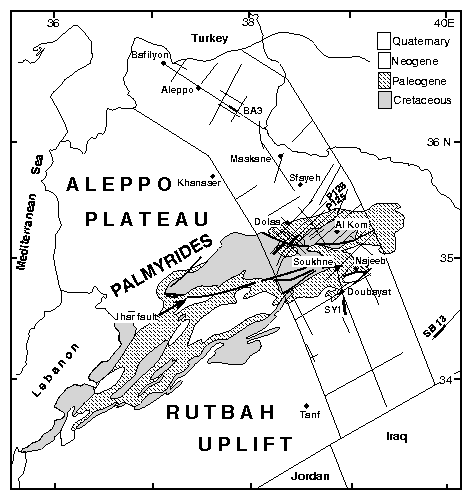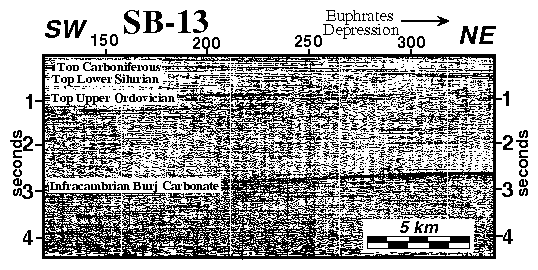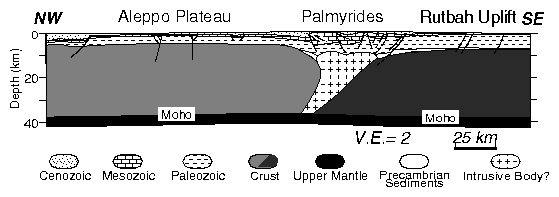Home |
Publications
Al-Saad, D., Sawaf, T., Gebran, A., Barazangi, M., Best, J.
A., and Chaimov, T. A.
Crustal structure of central Syria: The intracontinental Palmyride Mountain
belt
Tectonophysics, 207, 345-358, 1992.
Abstract
Along a 450 km transect across central Syria
seismic reflection data, borehole information, potential field data and surface
geologic mapping have been combined to examine the crustal structure of the northern
Arabian platform beneath Syria. The transect is surrounded by the major plate
boundaries of the Middle East, including the Dead Sea transform fault system along
the Levantine margin to the west, the Bitlis suture and East Anatolian fault to
the north, and the Zagros collisional belt to the northeast and east. Three main
tectonic provinces of the northern Arabian platform in Syria are crossed by this
transect from south to north: the Rutbah uplift, the Palmyra fold-thrust belt,
and the Aleppo plateau. The Rutbah uplift in southern Syria is a broad, domal
basement-cored structure with a thick Phanerozoic (mostly Paleozoic) cover of
6-7 km. Isopachs based on well and seismic reflection data indicate that this
region was an early Paleozoic depocenter. The Palmyra fold-thrust belt, the northeastern
arm of the Syrian Arc, is a northeast- southwest trending intracontinental mountain
belt that acts as a mobile tectonic zone between the relatively stable Rutbah
uplift to the south and the less stable Aleppo plateau to the north. Short wavelength
en echelon folds characterized by relatively steep, faulted southeast flanks dominate
in the southwest, most strongly deformed segment of the belt, while a complex
system of deeply rooted faults and broad folds characterize the northeast region,
described in this study. The Aleppo plateau lies immediately north of the Palmyride
belt, with a combined Paleozoic and Mesozoic sedimentary section that averages
4-5 km in thickness. Although this region appears relatively undeformed on seismic
reflection data when compared to Palmyride deformation, a system of near vertical,
probable strike-slip faults crosscut the region in a dominantly northeasterly
direction.
Gravity and magnetic modeling constrains the deep crustal structure along the
transect. The crustal thickness is estimated to be approximately 38 km. Interpretation
of the gravity data indicates two different crustal blocks beneath the Rutbah
uplift and the Aleppo plateau, and the presence of a crustal-penetrating, high-density
body beneath the northeast Palmyrides. The two distinct crustal blocks suggest
that they were accreted possibly along a suture zone and/or a major strike-slip
fault zone located approximately in the present-day position of the Palmyrides.
The age of the accretion is estimated to be Proterozoic or early Cambrian, based
on the observation of a pervasive reflection (interpreted as the Middle Cambrian
Burj limestone) in the Rutbah uplift and in the Aleppo plateau and by analogy
with the well-mapped Proterozoic sutures of the Arabian shield to the south.
{links to files, full text versions and/ or pdfs go here}
Copyright Statement
{copyright & links to publishers here}
Key Figures and Captions
Figure 1. Map showing the western part of Syria
including generalized geology of the Palmyride fold belt and location of the central
Syria transect that is the subject of this paper. Circles represent wells used
for correlation with seismic reflection profiles (narrow lines).

Figure 2. Portion of seismic line SB 13 showing the thickening
of Mesozoic and Cenozoic strata (upper 0.5 sec) in the direction of the Euphrates
depression to the east and the onlap of Silurian and Upper Ordovician rocks
onto the Lower Ordovician. See Figure 1 for Paleozoic extension. The nature
of the difference between the Rutbah and Aleppo crusts is uncertain because
of the ambiguity plateau is either thinner or denser than Rutbah crust.

Figure 3. Interpretive cross section to Moho (see Fig. 1
for location of transect). The high-density intrusive body may be associated
with early Paleozoic extension. The nature of the difference between the Rutbah
and Aleppo crusts is uncertain because of the ambiguity plateau is either thinner
or denser than Rutbah crust.

Home |
Publications



